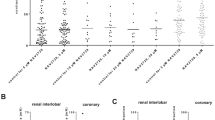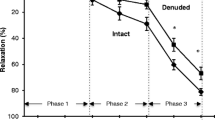Abstract.
In the guinea pig bronchus with epithelium, pre-contracted with histamine, bradykinin (BK), lysyl-BK, prostaglandin E2 (PGE2), cromakalim and S-nitroso-N-acetylpenicillamine each caused graded relaxation with mean EC50s of 34 nM, 11 nM, 0.1 nM, 0.3 µM and 3.4 µM, respectively. The addition of NO synthase inhibitors N W-nitro-l-arginine (L-NOARG), N G-monomethyl-l-arginine or 7-nitroindazole reduced BK-induced relaxation by 41±6%, 59±4% and 51±2%, respectively. The inhibition of BK response caused by L-NOARG was completely reversed by l-, but not by d-arginine. Methylene blue and 6-(phenylamino)-5,8-quinolinedione (LY 83583) inhibited the BK response by 88±5% and 64±4%, while 1H-[1,2,4]oxadiazolo[4,3-a]quinolaxin-1-one (ODQ) had no effect. However, ODQ almost abolished SNAP-induced relaxation.
Indomethacin and the cyclo-oxygenase 2 (COX-2) inhibitor 5,5-dimethyl-3-(3-fluorophenyl)-4-(4-methylsulfonyl)phenyl-2(5H)-furanone (DFU) caused graded inhibtion of BK responses with mean IC50s of 60 nM and 0.6 nM, respectively. Addition of tetraethylammonium (TEA), charybdotoxin (ChTx), or iberotoxin (IbTx) inhibited BK-induced relaxation by 76±4%, 30±4% and 99±1%, respectively, but the relaxations of PGE2 and cromakalim were unaffected. In contrast, 4-aminopyridine, apamin or glibenclamide did not affect BK-induced relaxation.
These results indicate that BK-induced epithelium-dependent relaxation in the guinea pig bronchus is partially mediated by release of NO or by NO-related substances, involving an activation of both cyclo-oxygenase 1 (COX-1) and COX-2 enzymes, through a cyclic guanosine monophosphate (cGMP)-independent mechanism. Furthermore, BK-induced relaxation involves an activation of high-conductance Ca2+-activated K+ channels highly sensitive to IbTx, and to a lesser extent to ChTx and TEA.
Similar content being viewed by others
Author information
Authors and Affiliations
Additional information
Electronic Publication
Rights and permissions
About this article
Cite this article
Mazzuco, T., André, E. & Calixto, J. Contribution of nitric oxide, prostanoids and Ca2+-activated K+ channels to the relaxant response of bradykinin in the guinea pig bronchus in vitro. Naunyn-Schmiedeberg's Arch Pharmacol 361, 383–390 (2000). https://doi.org/10.1007/s002109900201
Received:
Accepted:
Issue Date:
DOI: https://doi.org/10.1007/s002109900201




